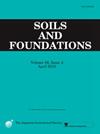Inverse analysis for estimating geotechnical parameters using physics-informed neural networks
IF 3.3
2区 工程技术
Q2 ENGINEERING, GEOLOGICAL
引用次数: 0
Abstract
Physics-informed neural networks (PINNs) have been proposed for incorporating physical laws into deep learning. PINNs can output solutions that satisfy physical laws by introducing information, such as partial differential equations (PDEs), boundary conditions, and initial conditions, into the loss functions used during the construction of the neural network model. This study presents two cases in which geotechnical parameters were estimated through an inverse analysis of PINNs. PINNs were applied to simulate consolidation and unsaturated seepage processes. The inverse analysis of the PINNs helped estimate the coefficient of consolidation and the parameters related to the unsaturated soil hydraulic properties with sufficient accuracy. The inverse analysis of PINNs for geotechnical parameter estimation was found to be an effective approach that utilizes measurement data.
利用物理信息神经网络进行反分析以估算岩土工程参数
有人提出了物理信息神经网络(PINN),用于将物理定律纳入深度学习。通过将偏微分方程 (PDE)、边界条件和初始条件等信息引入神经网络模型构建过程中使用的损失函数,PINN 可以输出满足物理规律的解决方案。本研究介绍了通过对 PINN 进行反分析来估算岩土参数的两个案例。PINNs 被用于模拟固结和非饱和渗流过程。对 PINNs 的反分析有助于估算出足够精确的固结系数和与非饱和土壤水力特性相关的参数。利用 PINN 进行岩土参数估计的反分析是一种利用测量数据的有效方法。
本文章由计算机程序翻译,如有差异,请以英文原文为准。
求助全文
约1分钟内获得全文
求助全文
来源期刊

Soils and Foundations
工程技术-地球科学综合
CiteScore
6.40
自引率
8.10%
发文量
99
审稿时长
5 months
期刊介绍:
Soils and Foundations is one of the leading journals in the field of soil mechanics and geotechnical engineering. It is the official journal of the Japanese Geotechnical Society (JGS)., The journal publishes a variety of original research paper, technical reports, technical notes, as well as the state-of-the-art reports upon invitation by the Editor, in the fields of soil and rock mechanics, geotechnical engineering, and environmental geotechnics. Since the publication of Volume 1, No.1 issue in June 1960, Soils and Foundations will celebrate the 60th anniversary in the year of 2020.
Soils and Foundations welcomes theoretical as well as practical work associated with the aforementioned field(s). Case studies that describe the original and interdisciplinary work applicable to geotechnical engineering are particularly encouraged. Discussions to each of the published articles are also welcomed in order to provide an avenue in which opinions of peers may be fed back or exchanged. In providing latest expertise on a specific topic, one issue out of six per year on average was allocated to include selected papers from the International Symposia which were held in Japan as well as overseas.
 求助内容:
求助内容: 应助结果提醒方式:
应助结果提醒方式:


